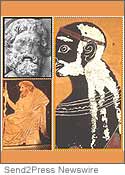ANNAPOLIS, Md. — Solving Light Books announced today the publication to the Web of 37 images of the Biblical Noah uncovered in ancient Greek art. The surprising Web Presentation includes written commentary by Robert Bowie Johnson, Jr., author of “The Parthenon Code: Mankind’s History in Marble” and most recently, “Noah in Ancient Greek Art” (ISBN 13: 978-0-9705438-4-4).
According to Johnson, ancient Greek artists and poets called Noah “Nereus” (meaning the “Wet One”), and also referred to him as the “Salt Sea Old Man.” Greek artists depicted Noah/Nereus in black-figure vase-scenes, red-figure vase-scenes, and in sculpture.
The Web presentation (solvinglight.com/features/37NoahsPartI.htm) shows that Greek artists depicted Noah/Nereus being threatened and pushed out of the way by the Greek hero and rebel, Herakles. Artists also portrayed Herakles as grabbing Noah/Nereus from behind, figuratively bringing him and his rule to a halt.
 Ancient vase-painters and sculptors also put Noah/Nereus into scenes as a solemn and dejected witness to key events heralding the takeover of Zeus-religion, including the defeat of his Yahweh-believing sons, and the birth of the serpent-friendly Athena.
Ancient vase-painters and sculptors also put Noah/Nereus into scenes as a solemn and dejected witness to key events heralding the takeover of Zeus-religion, including the defeat of his Yahweh-believing sons, and the birth of the serpent-friendly Athena.
“The prevailing notion in academic circles that Greek vase-artists and sculptors spent their lives depicting imaginary or “mythical” beings and events is absurd on its face. The Greek ‘gods’ look exactly like people, because that’s who they were-our ancestors,” Mr. Johnson said, pointing out that Socrates himself referred to Zeus, Apollo, and Athena as his “lords and ancestors.”
Mr. Johnson’s Web site (www.solvinglight.com) provides a wealth of documentation for his revolutionary new interpretation of ancient Greek art including:
* A short pictorial review of what Greek religious art actually chronicles and celebrates.
* An 8-page illustrated summary of the true meaning of Greek art entitled “Athena and Eve.”
* The east pediment of Parthenon reconstructed in color by computer (based on the physical evidence and substantiated by the relevant ancient art and literature) with the figures identified and the theme explained.
* The 12 labors of Herakles from the temple of Zeus at Olympia restored in color by computer, with an explanation of how each related to the Greeks’ rejection of Noah and his God, and how each fit into the Greeks’ contrary boast that “man is the measure of all things.”
* Evidence that the Greeks depicted Kain (Cain) killing Abel on the south side of the Parthenon.
* Sample sections from a 950-slide PowerPoint Presentation revealing the meaning of all seven of the Parthenon’s sculptural themes (eight themes, including Athena’s gold and ivory idol-image).
* Section IV of Mr. Johnson’s latest book, “Noah in Ancient Greek Art” explaining how the prevailing Darwinian paradigm has led to “The Mainstream’s Blindness to Our Origins.”
* How Greek artists depicted the line of Kain (Cain) disappearing into the earth during the Flood, and how their vase-depictions celebrated the rebirth of the line of Kain after the Flood.
“Ancient Greek religious art does not portray myth as is widely supposed, but rather the history of the human race told from the standpoint of the way of Kain. Like the Book of Genesis, Greek artists traced back their ancestors to a first couple in an ancient paradise with a serpent-entwined apple tree-only they believed that the serpent enlightened, rather than deluded, that first couple,” Mr. Johnson said.
“An enormous amount of information about mankind’s true origins hides in plain sight in the art of ancient Greece. The many images of the Greek version of the Biblical Noah, now made available to the public on the Web, are just a small part of it,” Mr. Johnson said.
Mr. Johnson’s first book on this subject, “Athena and Eden: The Hidden Meaning of the Parthenon’s East Facade” (2002) has been translated into French as “Athena et le Jardin d’Eden.” His book, “The Parthenon Code: Mankind’s History in Marble” has been translated into French, and into Greek. The book is currently the subject of much controversy in Greece.









